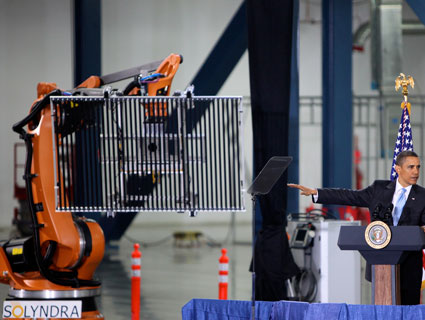
<a href="http://www.flickr.com/photos/31221015@N08/6289448209/">neimon2</a>/Flickr
The past couple of months have been grim ones for anybody who favors federal support of renewable energy. First, Solyndra declared bankruptcy, providing gleeful conservative skeptics with weeks of anti-solar headlines. Then this week Beacon Power, a flywheel storage company, followed Solyndra into bankruptcy, and an Energy Department watchdog told Congress that the DOE had been ill-equipped to quickly distribute the $35 billion in new funding it got from the 2009 stimulus bill.
So today let’s take a break from the gloom and look instead at some good news on the federally funded renewable power front. A couple of weeks ago, the National Renewable Energy Laboratory (NREL) announced a “game changing” new development in solar panel fabrication. It’s not sexy: It’s called the Optical Cavity Furnace, and it’s a new way of manufacturing solar cells that uses optics rather than radiant or infrared heat. There are a couple of big benefits to this new technology.
First, NREL says the new furnace uses around half the energy of traditional manufacturing processes, costs 25 to 50 percent less, and has faster process times. This means that solar panels can be made both faster and cheaper than before.
Second, because its optical technology is more precise, the solar cells it creates have a higher efficiency. “Our calculations show that some material that is at 16 percent efficiency now is capable of reaching 20 percent if we take advantage of these photonic effects,” NREL principal engineer Bhushan Sopori said. “That’s huge.” Lauren Simenauer and Sean Pool explain what this means:
The White House has challenged the solar industry to produce clean electricity at $1 per watt. It has also set a national goal to achieve 80 percent clean energy use by 2035…The good news is that researchers are racing toward that goal at an impressive rate.
In fact, the cost of photovoltaic, or PV, cells had already fallen 50 percent in the past two years prior to the DOE announcement. A June 2011 projection predicted PV module prices would hit the goal of $1 per watt by 2013; now the finish line of the proverbial “race to the bottom” seems even more imminent.
In a way, this is the quiet silver lining behind Solyndra’s highly publicized failure. Solyndra’s goal was to produce cheaper, better solar power, and it failed because other companies beat them to the punch. But this is good news. Whether it’s Solyndra or someone else, what’s important is that stiff competition in the solar sector is producing dramatic gains in solar efficiency. Ramez Naam provides the numbers:
Over the last 30 years, researchers have watched as the price of capturing solar energy has dropped exponentially. There’s now frequent talk of a “Moore’s law” in solar energy. In computing, Moore’s law dictates that the number of components that can be placed on a chip doubles every 18 months…If similar dynamics worked in solar power technology, then we would eventually have the solar equivalent of an iPhone—incredibly
cheap, mass distributed energy technology that was many times more effective than the giant and centralized technologies it was born from.
…Averaged over 30 years, the trend is for an annual 7 percent reduction in the dollars per watt of solar photovoltaic cells…If the 7 percent decline in costs continues (and 2010 and 2011 both look likely to beat that number), then in 20 years the cost per watt of PV cells will be just over 50 cents…The cost of solar, in the average location in the U.S., will cross the current average retail electricity price of 12 cents per kilowatt hour in around 2020, or 9 years from now…10 years later, in 2030, solar electricity is likely to cost half what coal electricity does today. Solar capacity is being built out at an exponential pace already. When the prices become so much more favorable than those of alternate energy sources, that pace will only accelerate.
Solar power isn’t the answer to all our energy needs. No matter how cheap it gets, we’ll still probably need nukes or natural gas to provide baseload power. But even if solar can only provide electricity during daylight hours — and improved storage technology may change even that in the future—daylight hours are when electricity use is highest. Combine cheap solar with hydro, wind, and, maybe, biofuels, and the need for fossil fuels could diminish dramatically over the next few decades. What’s more, the need for the worst of the fossil fuels, coal, could diminish even more.
All that depends a lot on how serious we get about this, but it depends even more on solar power getting cheaper than coal. Federally funded basic research, like NREL’s work on the Optical Cavity Furnace, is a key part of that.














